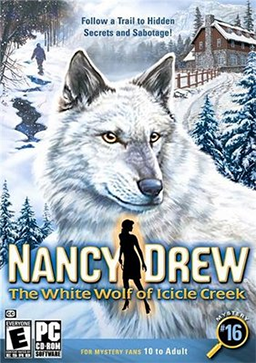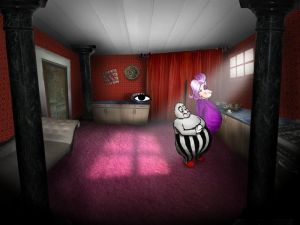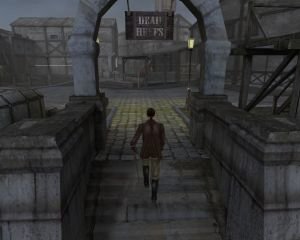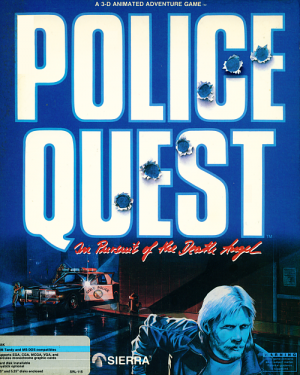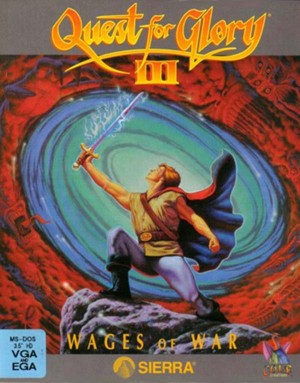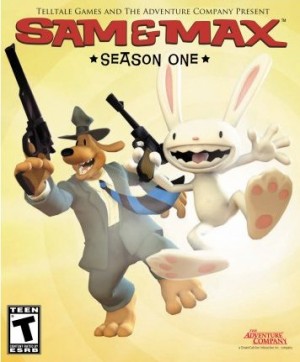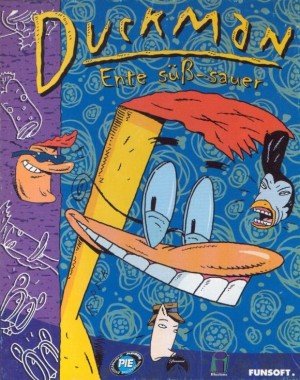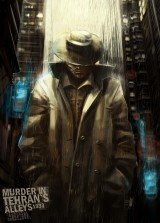Review for Conspiracies II: Lethal Networks

To paraphrase Frank Zappa, FMV isn't dead, it just smells funny.
When Greek developer anima-ppd published Conspiracies back in 2003, full motion video was already becoming a rarity in the adventure genre. With a dubious history of many bad live-action games and only a handful of good ones, there wasn't much appreciation for the film-based technique left from many players. As it turns out, Conspiracies had a compelling sci-fi story and some very challenging puzzles that made it a solid game, but the over-the-top acting, blocky graphics and long load times prevented it from being more memorable. Anima listened to those criticisms, however, and kept believing in the advantages of FMV, and has been busy working on a sequel ever since. After many long years, now it’s finally arrived, but while Conspiracies II: Lethal Networks certainly shows improvements in some areas, it suffers from a number of both technical and design issues that hamper its enjoyment, and even the first post-release patch can't solve them all.
Conspiracies followed the futuristic adventures of Nick Delios, a private detective who was out of luck and out of money. To clear his debts, he took on a case for the brother of his ex-fiancée Annita, which eventually snowballed into an intergalactic conspiracy of treacherous aliens. The game ended with a big cliffhanger, and now we finally learn what happens next, as Lethal Networks takes place a few months later. It is 2064, and Nick is part of the secret governmental investigation team researching the villainous aliens in order to learn their plans for the planet. Earth has been accepted as an equal member of the Peripheral Galactic Alliance, which should mean a better outlook from an economic and technological point of view, as mankind can only benefit from cooperation with other civilizations. But Nick isn't certain that all alien species mean well, and sure enough, he soon finds himself setting off on a whole new mission to save the world from impending doom, unravelling conspiracies and uncovering secrets across the galaxy. He even gets framed for an attempted murder he didn't have anything to do with, so he’ll have to prove his innocence as well.
It is not really necessary to have played Conspiracies to understand the sequel, as it largely stands on its own with only the occasional reference to Nick's “previous case”. The plot of Lethal Networks itself is quite long and full of twists, but it’s not very original. It revolves around trust and betrayal and finding out the true intentions of an intergalactic corporation, but it never goes into new territory and we've seen it all before. Nick gets to visit distant and fascinating planets, but you get hardly any information about their history or culture, which is a pity, as I'd have liked to know more about those places.
As with the last game, the environments here are three-dimensional and you freely steer Nick in first-person view with the arrow keys while looking around with the mouse. You can run by holding down the Shift key, though this isn’t much faster than the default walk speed. You can also occasionally climb ladders or rocks, and even crouch, which is used to get into small spaces or avoid being seen and shot by a guard. That's right, you can die in Lethal Networks, and it is not always clear when you are in a dangerous situation. If you die you will need to load a saved game manually, so it is important to hit the F4 button on a regular basis (there is no save option in the menu). Although load times have greatly decreased since the first game, restoring old saves is still a bit of a tedious process. Why not simply take players back to the point just before they made the wrong decision?
To interact with the environment, you simply click on anything you see once you're close enough. Originally there was no way to tell what items were interactive, but the recently-issued patch makes finding objects a bit easier by adding a hotspot highlight toggle that places big red arrows above them. This system still isn't flawless, however, as it projects arrows through walls and ceilings or places them above objects you no longer need. It often comes in handy, however, as it’s not always clear what you should be looking for. Many objects don't get used until hours later, but you can’t leave the area until you’ve found everything anyway, leaving you to search for things you don’t know you need for no logical reason.
Items that are too big to be picked up can sometimes be grabbed and dragged short distances, but objects you can collect end up in your inventory. There you can right-click them either for a description or to split them into other usable parts. You can also physically turn objects around to inspect them, and combine some on occasion. Fortunately, gone are the inventory limitations of the first game, so you can now carry an endless number of items. This is a great improvement, as you no longer have to plan what to bring on each 'trip'. The inventory is easily accessed with the Space bar, but once open there can be a huge difference between simply left-clicking to use an item and right-clicking it to view it first. If you try to use an object and are too far away from the intended target, Nick will simply throw it on the ground. For certain items, however, right-clicking them in inventory before trying to use them allows them to function across greater distances. This principle is applied very early on when you try to gain access to a mansion, and though it’s mentioned in the manual, the game itself gives you no hints as to why you aren't getting results by using the correct object with left-clicks only.
This isn’t the only time there’s a lack of adequate feedback. You don’t always get an explanation of Nick's actions and circumstances, leaving you in the dark about what is happening, what you’re supposed to do next or what you need to find to progress. One scene suddenly has Nick floating near the ceiling after using the same kind of room-to-room elevator he’s used several times before, yet it elicits only a very general comment from him. He doesn't seem aware that he is incapable of moving and won't even acknowledge that anything is amiss. A few objects are nearby but just out of reach, and Nick isn’t bothered by this either. Since you cannot even access the game's menu at this point, the whole scenario appears to be a glitch. If only Nick had said something even mildly relevant in context, it would have been obvious this was actually a puzzle. There are other instances of insufficient clues as well, and a large part of the game is spent walking around previously visited locations, scrounging for any items you may have missed and combining them at random until you finally find the one thing that solves the puzzle or triggers the next scene.
Besides overcoming inventory obstacles, puzzles you encounter include breaking codes, getting complex machines to work and even choosing the right dialogue options. Most of the puzzles are quite challenging and will keep you stumped for quite some time, in a good way, but some are so obscure and illogical that they are particularly difficult. There are many red herrings in the game as well, like computers that require a password or doors with keypad locks that you can interact with. You won’t know at the time that there is no solution to these, as they seem to have been added only to distract you from the true goal. Similarly, many characters you talk to have a huge list of repetitive subjects to choose from, and although only a few of them offer a valuable response, you’ll feel obliged to go through them all anyway, since you never know when an important detail might turn up. And you’ll need to do it each and every time you talk to them, as they may have learned something new since the last time you spoke.
Another annoyance is a lengthy sequence in which you have a limited time to escape a prison. There is not nearly enough time to explore thoroughly, and when you inevitably run out of time (there is no visible clock, but you can hear it ticking) you end up with the dreaded 'game over' screen. This scenario can only be overcome by memorising the locations of all the objects you need and trying to get a little bit further every time. Many of these objects are well hidden, and some unintuitive puzzle solutions make it very hard to figure out what you need to do, so you can expect to die many times until you finally get it right. The game also contains a large maze littered with items you’ll need to find, though they have no current use in your search for the exit. Worse still, though the patch addresses a number of original bugs and glitches that lead to missed puzzles and potential dead ends, it doesn't solve all of them. They're rare now, but you may yet experience some game-breaking technical issues.
In total, there are about a dozen central locations in the game, ranging from a luxurious mansion to a spaceport to a bar on another planet, each spanning several rooms or buildings to explore. These manage to convey a futuristic setting quite well, using weird-looking furniture and plants for decoration, equipping people with strange gadgets and showing occasional flying spaceships in the background. On the other hand, certain clothing seems quite old-fashioned while some inventions seem too advanced for only fifty years from now, which detracts somewhat from the believability. As with the previous game, the computer-generated backgrounds don’t look nearly as nice as the FMV backdrops, and in some scenes characters can appear unnaturally grafted in. The static backgrounds you explore are generously interspersed with live-action cinematics that total about two-and-a-half hours altogether, mostly delivered in short scenes that last a few minutes each. These are filmed nicely and look a great deal better than the video clips in the first game.
The characters Nick meets are diverse and interesting, but they are stereotypical enough that it is quite obvious who you can and cannot trust. Most of them are human, with only a single alien present in one cutscene, and even then you don’t get to interact with it directly. Many characters will be familiar to those who played Conspiracies, including Annita, Nick’s police friend Thanos, a lawyer and a bar owner, though some have new jobs this time around. The manual has a very handy page with head shots and brief descriptions of key characters, so you can look someone up if you lose track of who’s who.
The developers have gone out of their way to make this game widely accessible by providing both subtitles and spoken voices in Greek and English, plus additional subtitles in German, French, Dutch and Spanish. The English translation is adequate, though the occasional spelling and grammatical errors do pop up, as well as some inconsistency with names. The Greek voiceovers are much better than the dubbed English ones, so the best way to enjoy the game is playing in the original language with localized subtitles to suit your preference. The English performances are a mixture of emotionally bland, relatively okay, and over-the-top. Regardless of the language, most of the actors look convincing on screen, but a few of them are B-movie material at best.
There is only 90 minutes of music played throughout the course of the game. That may sound like a lot, but even with periods of silence factored in, the soundtrack becomes rather repetitive during the substantial 30-plus hours it takes to reach the end. In one or two locations, it really got on my nerves to hear the same electronic beat repeated all the time. Fortunately, in other scenes it’s more laid-back and orchestral, and not nearly so obtrusive. Sound effects are limited to realistic-sounding noises of doors, drawers and closets opening and closing, humming machines, and bleeping computers, though some corners have been cut in this area, such as rocks hitting (or even passing through) windows with no audible result.
The story is periodically brought to a halt by the need to search for objects you don’t know you need yet, compounded by a lack of feedback about what is happening and why, but when it is allowed to flow, it is nicely written and entertaining, eventually leading to two possible endings, depending on which of two companions you choose to play in the final few minutes. One result is clearly the ‘good’ ending and the other one bad, though it should be fairly obvious which is which when making your decision. Either way, the ending is a cliffhanger again, so I guess we'll have to wait for Conspiracies III to find out what happens to Nick.
Currently available for ordering only through the developer's website, Lethal Networks clearly shows the value of all those years spent in production, with hours of quality FMV scenes, a substantial storyline and challenging puzzles, but the game would have benefited greatly from improved feedback, more user-friendly design decisions and added technical polish to smooth out the rough edges. As it is, this won’t be the game to revive flagging popular interest in FMV adventures, but the ongoing saga of Nick Delios should still appeal to those who like live-action adventures and futuristic sci-fi mysteries. Just remember to save your game periodically while you're out saving the world.
Update: A second patch is now available that introduces a more dynamic hotspot highlight system (activated with the TAB key), which indicates the means of possible interaction via different icons.


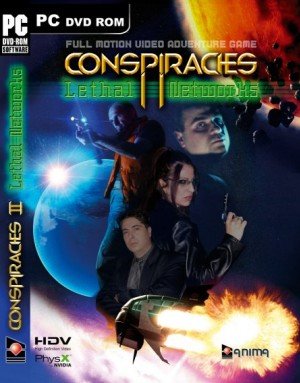
_capsule_fog__medium.png)






